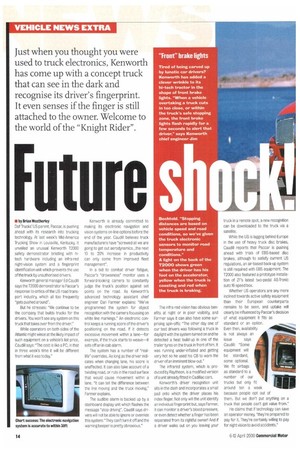Future
Page 16

If you've noticed an error in this article please click here to report it so we can fix it.
• by Brian Weatherley
Daf Trucks' US parent, Paccar, is pushq ahead with its research into trucking technology At last week's Mid-America Trucking Show in Louisville, Kentucky, it unveiled an unusual Kenworth T2000 safety demonstrator bristling with hitech hardware including an infra-red night-vision system and a fingerprint identification unit which prevents the use of the truck by unauthorised drivers.
Kenworth general manager Ed Caudill says the T2000 demonstrator is Paccar's response to critics of the US road transport industry, which all too frequently "gets pushed around".
But he stresses: "We continue to be the company that builds trucks for the drivers. You won't see any system on this truck that takes over from the driver."
While operators on both sides of the Atlantic might wince at the likely impact of such equipment on a vehicle's list price, Caudill says: "The cost is like a PC, in that in three week's time it will be different from what it was today." Kenworth is already committed to making its electronic navigation and vision systems on-line options before the end of the year. Caudill believes truck manufacturers have "screwed all we are going to get out aerodynamics...the next 10 to 20% increase in productivity can only come from improved fleet management".
In a bid to combat driver fatigue, Paccar's "drowsiness' monitor uses a forward-looking camera to constantly judge the truck's position against set points on the road. As Kenworth's advanced technology assistant chief engineer Dan Farmer explains: "We've programmed the system for object recognition with the camera focussing on white line markings." An electronic control keeps a running score of the driver's positioning on the road. If it detects excessive movement within a lane—for example, if the truck starts to weave—it sets off an in-cab alarm.
The system has a number of "reallife" overrides. As long as the driver indicates when changing lane, his score is unaffected. It can also take account of a twisting road, or ruts in the road surface that would cause movement within a lane. "It can tell the difference between the line moving and the truck moving," Farmer explains.
The audible alarm is backed up by a dashboard display unit which flashes the message "stop driving". Caudill says drivers will not be able to ignore or override this system: "They can't turn it off and the warning beeper is pretty obnoxious." The infra-red vision has obvious benefits at night or in poor visibility, and Farmer says it can also have some surprising spin-offs: "The other day one of our test drivers was following a truck in daylight with the system turned on and he detected a heat build-up in one of the trailer tyres on the truck in front of him. It was running under-inflated and getting very hot so he used his CB to warn the driver of an imminent blow-out."
The infrared system, which is produced by Raytheon, is a modified version of a unit already fitted in Cadillac cars.
Kenworth's driver recognition unit sits in the dash and incorporates a small pad onto which the driver places his index finger. Not only will the unit identify an individual fingerprint but, says Farmer, it can monitor a driver's blood pressure, or even detect whether a finger has been separated from its rightful owner! And if a driver walks out on you leaving your truck in a remote spot, a new recognition can be downloaded to the truck via a satellite.
While the US is lagging behind Europe in the use of heavy truck disc brakes, Caudill reports that Paccar is pushing ahead with trials of EBS-based disc brakes, although to satisfy current US regulations, an air-based back-up system is still required with EBS equipment. The T2000 also featured a prototype installation of ZF's latest two-pedal AS-Tronic auto 16-speed box.
Whether US operators are any more inclined towards active safety equipment than their European counterparts remains to be seen, and uptake will clearly be influenced by Paccar's decision of what equipment it fits as standard or an option. Even then, availability is not always an issue says Caudill: "Some equipment will be standard, some optional. We fit airbags as standard to a number of our trucks but only fit around ten a week because people opt out of them. But we don't put anything on a truck that people can't get value from.'
He claims that if technology can save an operator money, "they're prepared to pay for it. They're certainly willing to pay for night vision to avoid accidents."




















































































































